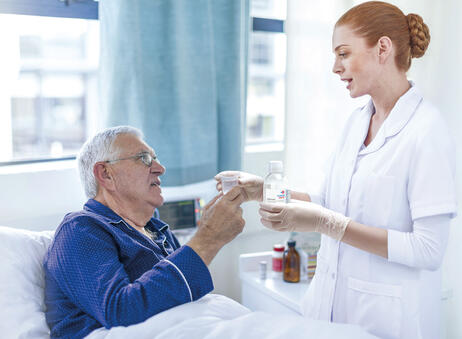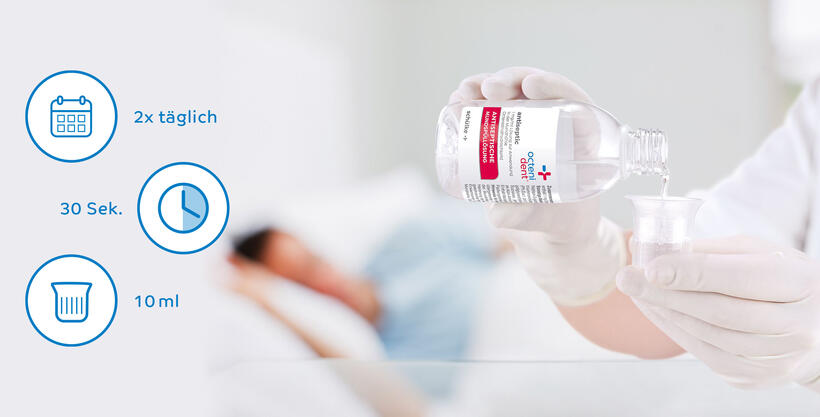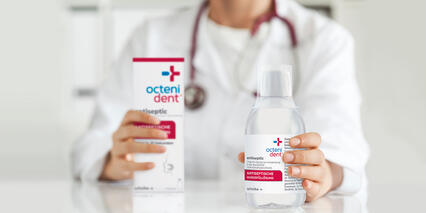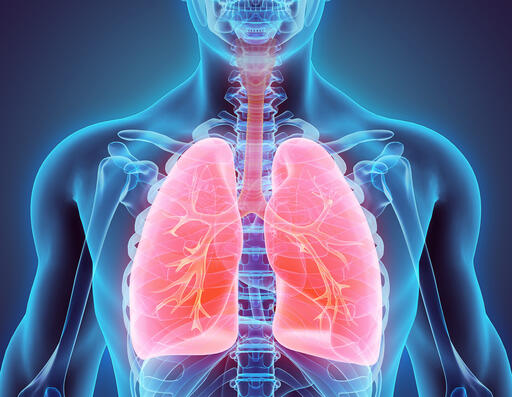
Antiseptic mouthwash for patients
The use of antiseptic mouthwashes is recommended in order to be able to care for patients even during a phase of reduced oral hygiene. They help prevent gingivitis and periodontitis and can reduce the risk of infections. Find out more about oral antiseptics in the following article.
Get the information you need with just one click:
Ensuring oral care with antiseptic mouthwashes
As part of patient hygiene, oral care is an important component in achieving a temporary reduction in the bacterial load in the oral cavity. Germs can lead to gum disease (gingivitis, periodontitis) and infections, especially in patients with risk factors.1 Antiseptic mouth wash can help to reduce the bacterial and levorucidal germ load.2
Prevent risks with antiseptic mouthwashes
The first bacteria start to colonize again just two hours after brushing your teeth.3 Over time, other, mostly harmless bacteria are added and form a matrix of sugar and proteins - a biofilm (plaque) develops. About two days later, potentially pathogenic germs settle.4 Careful dental care helps to inhibit the colonization of germs. If oral hygiene is limited, the use of an antiseptic mouthwash is an alternative to mechanical tooth cleaning.
Without comprehensive oral care (tooth brushing and dental hygiene), a dental plaque consisting of hardened bacterial deposits develops within 72 hours.4 This leads to changes in the oral flora from originally Streptococcus and Actinomyces spp. to aerobic Gram-negative bacteria.5 As a result, health consequences such as gum disease and infections can occur, so that planned operations may have to be postponed. 6
Gingivitis
Gingivitis (inflammation of the gums) can affect practically any adult and is mainly caused by poor oral hygiene.7 Bacteria of the physiological oral flora find plenty of food on the teeth due to plaque formation and multiply there in large numbers.
This results in redness, swelling and a tendency to bleed. Some underlying diseases (e.g. diabetes mellitus) and certain lifestyle factors (e.g. nicotine consumption) can increase the risk of developing gingivitis.7
Periodontitis
Periodontitis is considered a widespread disease - around one in two young adults aged between 35 and 44 is affected (prevalence 52 out of 100).8 In Germany, around 8 million people are affected by severe periodontitis.9 Periodontitis occurs more frequently with increasing age. It is a chronic disease that can develop from gingivitis. The metabolic products of the bacteria in the plaque cause the gums to become inflamed and swollen. If the infection progresses and spreads to the periodontium, this is known as periodontitis. Classic symptoms are redness, swelling, bleeding tendencies, pain and exposed tooth necks. In the long term, the infection can lead to the breakdown of bone tissue, which in the worst case can result in tooth loss.10
Oral thrush
Oral thrush, also known as tongue fungus or mouth fungus, is caused by the colonization of certain yeast fungi, usually Candida albicans, on the oral mucosa in the mouth and throat.11 Indications of oral thrush are white plaque, altered sense of taste and reddened, sometimes slightly bleeding, oral mucosa under the plaque. The causes of oral thrush in adults usually lie either locally in the oral cavity or in the weakened immune system. As a result, nutritional problems can occur, as pain is triggered when eating and drinking (especially with acidic foods)12.
Prevention of respiratory infections

Optimal oral hygiene through tooth brushing and dental care is not always feasible in care facilities or on hospital wards. This can lead to gum disease, oral thrush and serious pneumonia. In Germany, ventilator-associated pneumonia (VAP) is one of the most common hospital infections.13 In the case of VAP, hospital stays can be extended by 6-9 days14,15 and additional costs of up to €30,000 per patient can be incurred.16,17,18,19,20
To prevent nosocomial ventilator-associated pneumonia, the KRINKO guideline "Prevention of nosocomial ventilator-associated pneumonia" recommends regular oral care with antiseptic substances with proven efficacy, among other things.21
Antiseptic mouth wash octenident® antiseptic
The use of the antiseptic mouth wash octenident® antiseptic can temporarily replace tooth brushing in adults with limited oral hygiene skills and contribute to the following:
- Temporary reduction in the number of germs in the oral cavity.
- Temporary inhibition of plaque formation.
This approved medicine contains the active ingredient octenidine dihydrochloride (octenidine). It has a bactericidal (Gram-positive and Gram-negative bacteria) and levurocidal* effect and is therefore also effective in vitro against Candida albicans, one of the main pathogens responsible for oral thrush. This antiseptic mouthwash solution is also well tolerated, has low systemic absorption and can be used during pregnancy**.
Further advantages of octenident® antiseptic:
- fast onset of action
- alcohol-free
- with mint flavor for improved patient compliance
* Fast onset of action: Bactericidal after 30 seconds and levurocidal after 60 seconds (levurocidal efficacy proven in vitro).
** Note the technical information.
Instructions for use

Patients: use octenident® antiseptic twice a day - preferably after meals. If this antiseptic is used immediately after brushing teeth, the mouth must be rinsed thoroughly with water before using octenident® antiseptic. Pour 10 ml of the antiseptic mouth wash solution into the measuring cup provided and rinse the mouth thoroughly for about 30 seconds. Then spit out the solution. This should not be swallowed. Do not rinse the mouth with water immediately afterwards. Do not use this medicine for more than five consecutive days.
Effective protection in the oral cavity with an antiseptic mouthwash solution
Effectively combat the main causes of gingivitis and periodontitis with octenident® antiseptic.

octenident® antiseptic 1 mg/ml oromucosal solution - Active substance: octenidine dihydrochloride. Composition: 1 ml of solution contains 1 mg of octenidine dihydrochloride. Other ingredients: glycerol 85 per cent (E 422), sodium gluconate, citric acid, disodium phosphate dihydrate (for pH adjustment), macrogolglycerol hydroxystearate, sucralose, purified water, mint flavour (contains propylene glycol (E 1520)). Indications: octenident antiseptic has an antimicrobial effect. It is used for temporary reduction of bacterial count in the oral cavity, for temporary inhibition of plaque formation, and in cases of insufficient oral hygiene capacity (no toothbrushing possible, for example) in adults. Contraindications: Allergy to octenidine dihydrochloride or any of the other ingredients. Undesirable effects: Very common: Temporary taste disturbance, such as bitter aftertaste; Mild, reversible dental discoloration. Common: Numb sensation in the mouth, Coating of the mouth or the tongue, Temporary tongue discoloration, Sensitivity of teeth. Uncommon: Headache, Nausea, Tingling of the tongue, More saliva in the mouth than normal.Revision 09/21
If any of the side effects get serious, or if you notice any side effects not listed in this user information, please tell your doctor or pharmacist.
Schülke & Mayr GmbH, 22840 Norderstedt, Germany, Tel. +49 40 52100-666, info@schuelke.com
1 Kriebel et al., 2018, Front.
2 SK3 guideline (long version); Domestic chemical biofilm management in the prevention and treatment of gingivitis, AWMF registry number: 083-016, status: November 2018, amendment: December 2020 https://www.awmf.org/uploads/tx_szleitlinien/083-016l_S3_Haeusliches-chemisches-Biofilmmanagement-Praevention-Therapie-Gingivitis_2021-02.pdf 3 Dhir 2013, Journal of Indian Society of Periodontology.
4 Munro CL, Grap MJ. Oral health and care in the intensive care unit: state of the science. Am J Crit Care 2004 Jan;13(1):25-33.
5 Berry AM, Davidson PM. Beyond comfort: Oral hygiene as a critical nursing activity in the intensive care unit. Intensive Crit Care Nurs 2006 Jun.
6 S2k guideline (short version); dental sanitation before heart valve replacement, AWMF registry number: 007-096, as of April 201
7 "How does gingivitis develop and how can it be treated?" DAZ.online, https://www.deutsche-apotheker-zeitung.de/news/artikel/2019/11/01/wie-kommt-es-zu-einer-gingivitis-und-wie-kann-sie-therapiert-werden. Accessed July 15, 2022.
8 "Fünfte Deutsche Mundgesundheitsstudie (DMS V) -Kurzfassung Institut der Deutschen Zahnärzte im Auftrag von Bundeszahnärztekammer und Kassenzahnärztlicher Bundesvereinigung". Bzaek.de, https://www.bzaek.de/fileadmin/PDFs/dms/Zusammenfassung_DMS_V.pdf. P.21. Accessed July 14, 2022.
9 AWMF- Arbeitsgemeinschaft der Wissenschaftlichen Medizinischen Fachgesellschaften e.V.. S3 Guideline (short version) "Domestic chemical biofilm management in the prevention and treatment of gingivitis." As of November 2018
10 "Periodontitis". Health Knowledge Foundation, https://www.stiftung-gesundheitswissen.de/wissen/parodontitis/hintergrund. Accessed July 18, 2022.
11 "Oral thrush". Christina Trappe, NetDoktor. 09.12.2021. https://www.netdoktor.de/krankheiten/soor/mundsoor/#:~:text=Mundsoor%20bei%20Erwachsenen%20betrifft%20häufiger,Kortison)%20occurs%20occasionally%20with%20 oral thrush. Accessed 26.08.2022.
12 "Mundsoor bei Pflegebedürftigen". Ramona Rühl. https://www.pflege.de/krankheiten/mundsoor/. Accessed 23.08.2022.
13 Rello, Jordi; Kollef, Martin H.; Diaz, Emili; Rodriguez, Alejandro (2010): Critical Care Infectious Diseases. Dordrecht: Springe
14 Beyersmann J, Gastmeier P, Grundmann H et al (2006) Use of multistate modelsto assess prolongation of intensive care unitstay due to nosocomial infection. Infect Control Hosp Epidemiol 27:493-499.
15 Eber MR, Laxminarayan R, Perencevich EN, Malani A (2010) Clinical and economic outcomes attributable to health care-associated sepsis and pneumonia. Arch Intern Med 170:347-353.
16 Hunter JD: Ventilator associated pneumonia. BMJ 2012, 344: e3325. 10.1136/bmj.e3325.
17 VAN NIEUWENHOVEN, E. BUSKENS, D.C. BERGMANS, F.H. VAN THIEL, G. RAMSAY et J.M. BONTEN, Oral decontamination is cost-saving in the prevention of ventilator associated pneumonia in intensive care units, 2004.
18 R.F. ABIDIA, Oral Care in the Intensive Care Unit : A Review, The Journal of Contemporary Dental Practice, Volume 8, No. 1, January 2007.
19 R. GARCIA, A review of the possible role of oral and dental colonization on the occurrence of health care-associated pneumonia: Underappreciated risk and a call for interventions, AJIC, November 2005
20 R. GARCIA, L. JENDRESKY, L. COLBERT, A. BAILEY, M. ZAMAN et M. MAJUMDER, Reducing Ventilator-Associated Pneumonia Through Advanced Oral-Dental Care: A 48-Month Study, AJCC, July 2009.
21 "Prävention der nosokomialen ventilator-associated pneumonia: Empfehlung der Kommission für Krankenhaushygiene und Infektionsprävention (KRINKO) beim Robert Koch-Institut". Bundesgesundheitsblatt, Gesundheitsforschung, Gesundheitsschutz, Vol. 56, No. 11, 2013, pp. 1578-1590, doi:10.1007/s00103-013-1846-7.
Data protection notice
We use analysis methods (e.g. cookies) to measure how often our website is visited and how it is used. We also use cookies to link your page visits and website usage with your customer data stored in our CRM system in order to be able to address you individually, i.e. based on your interests and usage. We alsowe embed third-party content from other providers (e.g. videos). We have no influence on further data processing and any tracking by the third-party provider.In this context, we also use service providers in third countries outside the EU that may not guarantee an adequate level of data protection, which entails the following risks Access by authorities without informing the data subject, no data subject rights, no legal remedies, loss of control.By hiring us, you consent to the processes described above. You can revoke your consent with effect for the future. You can find more information in our privacy policy


















